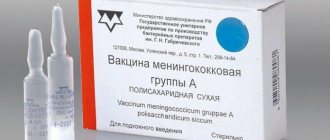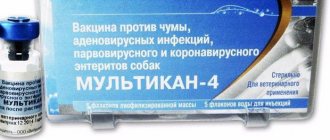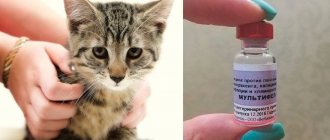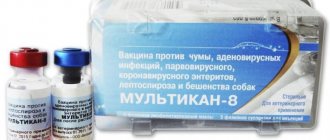Scheme and method of administration of the Synflorix vaccine
In order to identify contraindications, the doctor conducts a survey and examination of the vaccinated person on the day of vaccination with mandatory thermometry.
Instructions for use SYNFLORIX™
As with other injectable vaccines, vaccine recipients should be under medical supervision, and medical care should be available in the rare event of an anaphylactic reaction following vaccine administration.
The potential risk of apnea and the need to monitor respiratory function for 48-72 hours should be taken into account when conducting primary immunization in very premature infants (born at ≤28 weeks' gestation) and, especially in children with a history of respiratory immaturity. Due to the high benefits of vaccination for this group of children, its implementation cannot be canceled or postponed.
Synflorix™ should under no circumstances be administered intravascularly or intravenously. There are no data on subcutaneous administration of Synflorix™.
In children over 2 years of age, after vaccination or sometimes before it, fainting is possible as a psychogenic reaction to the injection. Before vaccination, it is important to make sure that the child will not be harmed if he faints.
As with other vaccines administered IM, Synflorix™ should be administered with caution to patients with thrombocytopenia or coagulation disorders due to the risk of bleeding with IM administration.
Official recommendations for immunization against diphtheria, tetanus and Haemophilus influenzae type b should also be followed.
There is insufficient evidence that Synflorix™ provides protection against pneumococcal serotypes not included in the vaccine, with the exception of cross-reacting serotype 19A (see section “Pharmacological action”), or against non-typeable Haemophilus influenzae. Synflorix™ does not provide protection against other microorganisms.
As with other vaccines, protective immune responses to invasive pneumococcal infections, pneumonia, or otitis media caused by vaccine serotypes and cross-reacting serotype 19A may not be achieved in all vaccine recipients. In addition, because otitis media and pneumonia can be caused by a large number of organisms other than the Streptococcus pneumoniae serotypes included in the vaccine, it is expected that the overall protective response against these diseases will be limited and significantly weaker than the protective response against invasive diseases caused by vaccine serotypes and serotype 19A (see section “Pharmacological action”).
In clinical studies, the Synflorix™ vaccine induced an immune response to all 10 serotypes included in the vaccine, but the degree of response varied among different serotypes. The functional immune response to serotypes 1 and 5 was weaker than to all other vaccine serotypes. It is unknown whether this reduction in functional immune response to serotypes 1 and 5 translates into reduced protective efficacy against invasive infections, pneumonia, or otitis media caused by these serotypes.
Synflorix™ vaccine is indicated for use in children aged 6 weeks to 5 years. The vaccination schedule is determined in accordance with the age of the child at the time of the start of the vaccination course. There are no data on the safety and immunogenicity of the vaccine in children over 5 years of age.
Children with a compromised immune status due to immunosuppressive therapy, a genetic defect, HIV infection, prenatal exposure to antiretroviral therapy and/or HIV, or other causes may have decreased antibody production following immunization.
Data are available on the safety and immunogenicity of the vaccine when used in children with HIV infection (asymptomatic or mildly symptomatic, according to WHO classification), HIV-negative children born to HIV-positive mothers, and children with sickle cell disease ( see sections “Side effects” and “Pharmacological effects”). Data on the safety and immunogenicity of the Synflorix™ vaccine when used in other groups of people with weakened immune systems are not available and the issue of vaccination should be considered individually in each specific case (see section "Dosage regimen").
Children under 2 years of age should receive an age-appropriate course of immunization with Synflorix™ vaccine (see Dosage Regimen). The use of pneumococcal conjugate vaccine does not replace the use of the 23-valent pneumococcal polysaccharide vaccine in children ≥2 years of age with medical conditions (such as sickle cell disease, asplenia, HIV infection, chronic illness, or other immune disorders) that are a risk factor for developing invasive diseases. diseases caused by Streptococcus pneumoniae. When recommended, at-risk children ≥24 months of age and already vaccinated with Synflorix™ should receive the 23-valent pneumococcal polysaccharide vaccine. The interval between administration of pneumococcal conjugate vaccine (Synflorix™) and 23-valent pneumococcal polysaccharide vaccine should be at least 8 weeks. There is no data available on whether administration of pneumococcal polysaccharide vaccine to children who received primary immunization with Synflorix™ vaccine results in hyporesponsiveness to subsequent doses of pneumococcal polysaccharide vaccine or pneumococcal conjugate vaccine.
Prophylactic use of antipyretics before or immediately after vaccine administration may reduce the frequency and intensity of post-vaccination febrile reactions. Clinical data obtained with paracetamol and ibuprofen suggest that prophylactic use of paracetamol may reduce the incidence of fever, whereas prophylactic use of ibuprofen has demonstrated a limited effect in reducing the incidence of fever. Clinical data suggest that prophylactic use of paracetamol may reduce the immune response to Synflorix™ vaccine. However, the clinical significance of these data is unknown.
Prophylactic use of antipyretics is recommended:
- for all children receiving Synflorix™ simultaneously with other vaccines containing whole-cell pertussis component, due to an increased incidence of febrile reactions (see section "Side effects");
- for children with convulsive syndromes or a history of febrile seizures.
Treatment with antipyretic drugs should be carried out in accordance with local guidelines.
Impact on the ability to drive vehicles and operate machinery
Not applicable because the drug is indicated for children aged 6 weeks to 5 years.
Contraindications
Only a doctor can decide whether SYNFLORIX is suitable for vaccination
SYNFLORIX is contraindicated if you have a history of an allergic reaction to any component of the vaccine.
Vaccination with SYNFLORIX is contraindicated in the following cases:
- Hypersensitivity to any component of the vaccine.
- Acute infectious and non-infectious diseases, exacerbation of chronic diseases are temporary contraindications for vaccinations. Vaccinations are carried out 2-4 weeks after recovery or during the period of convalescence or remission. For mild ARVI, acute intestinal diseases, etc., vaccinations are carried out immediately after the temperature has normalized. If you have mild cold symptoms, you should not delay vaccination.
How is vaccination carried out?
Vaccination is carried out in a vaccination room, in compliance with all sanitary requirements. All drugs are certified. A certificate for the drug is provided upon request.
Without reminders, before vaccination, the medical worker must show the drug and the expiration date of the vaccine.
Only sterile and disposable instruments are used. The vaccination must be carried out using disposable medical gloves.
On the day of vaccination, the child is examined by a pediatrician and the temperature is measured. In the absence of contraindications, vaccination is carried out. Information about the vaccination performed is entered into the card, vaccination certificate, and detailed recommendations for caring for the child in the post-vaccination period are given.
Before vaccination, the doctor will answer all your questions. Be sure to bring information about previous vaccinations to your appointment!
Please note that vaccination of a child, Mantoux test, Diaskintest can only be carried out in the presence of parents or legal representatives of the child (guardians), or if the accompanying person has a NOTARIZED power of attorney to carry out the manipulation (indicating the drug planned for administration) . Otherwise, vaccination will be denied. We comply with the laws of the Russian Federation.
Only here!
How to help your young child feel comfortable during vaccinations
Vaccination works better when the baby is calm and not afraid. To avoid scaring your child, try the following:
- Distract and calm your baby, hug him, talk softly to him
- Be calm, confident, smile.
- Maintain eye contact with your child.
- Communicate with your child, show that you are nearby and everything is fine.
- Let your child hold a favorite toy or blanket.
- Ask your doctor if you can hold your baby on your lap and gently rub his back during vaccination.
- Be sure to praise your child after vaccination, tell him how great he is and how proud you are of him. Support your baby, even if he couldn't help but cry.
Possible side effects
The most common adverse reactions during the initial course of vaccination were redness at the injection site, fever, irritability of the child, and loss of appetite. Headache, drowsiness, abnormal crying, allergic reactions, apnea in premature infants, and lumps at the injection site may also occur.
Come get vaccinated at Aqua-Doctor. A full range of vaccines for children and adults, family vaccinations - at a special price!
Call a doctor at home Make an appointment with a doctor Or by phone +7










